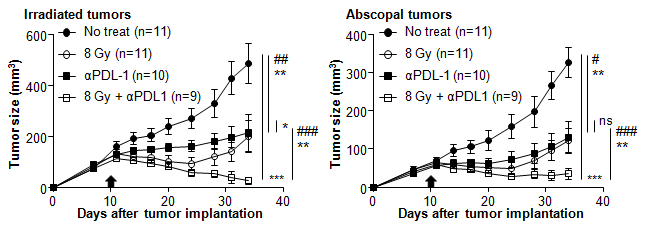글로벌 연구동향
방사선생물학
- 2021년 02월호
[Int J Radiat Oncol Biol Phys.] Enlightening the immune mechanism of the abscopal effect in a murine HCC model and overcoming the late resistance with anti PD-L1 동물모델에서의 abscopal효과의 면역기전인제대 / 박진희, 박세광*
- 출처
- Int J Radiat Oncol Biol Phys.
- 등재일
- 2020 Dec 28
- 저널이슈번호
- S0360-3016(20)34724-6. doi: 10.1016/j.ijrobp.2020.12.031.
- 내용
-
Abstract
Purpose: The establishment of a preclinical model of the abscopal effect on HCC and evaluation on whether the hypofractionated RT multi-tumor Hepa1-6 mouse HCC model could be used to suppress non-radiated tumor mass would be implemented in this study.Methods and materials: Hepa1-6 mouse liver cancer cell lines were used to form tumors and immunogenicity was analyzed using ELISpot and immune cell labeled antibody. Interferonβ (IFNβ) expression was confirmed through PCR.
Results: After investigation, the intratumoral transcription of type Ⅰ IFN increased by 2-fold. The anti-tumor immune response to Hepa 1-6 cells induced by radiation was increased. Moreover, the influx of activated CD8+ T cell was increased in non-irradiated tumors. The number of dendritic cells and activation status were evaluated by flow cytometry on the second day after irradiation. The flow cytometry presented significantly increased DC population expressing the CD11c molecule in tumor draining lymph nodes. Furthermore, as the irradiation leads to adaptation of immune resistance of tumor cells against RT, we explored to elucidate potent tool to overcome the resistance and confirmed the capability of PD-L1 antibody to survive the late RT resistance.
Conclusions: The immunological mechanism of the abscopal effect was revealed and the application of PD-L1 inhibitor successfully performed as a breakthrough to the late RT resistance in Hepa1-6 tumor model.

방사선치료에 따른 abscopal 효과의 발생과 면역관문 억제 항체 치료의 병용에 따른 치료효과 증가 결과

방사선치료에 따른 abscopal 효과의 발생 기전
Affiliations
Jin Hee Park 1 , Hee Yeon Kim 2 , Anbok Lee 2 , Young Kyeong Seo 3 , Il-Hwan Kim 4 , Eun-Tae Park 5 , Mi Seon Kang 6 , Sung Jae Park 7 , SaeGwang Park 8
1 Department of Microbiology, College of Medicine, Inje University, Busan, Republic of Korea.
2 Departments of Surgery, Busan Paik Hospital, College of Medicine, Inje University, Busan, Republic of Korea.
3 Departments of Internal Medicine, Busan Paik Hospital, College of Medicine, Inje University, Busan, Republic of Korea.
4 Departments of Internal Medicine, Haeundae Paik Hospital, College of Medicine, Inje University, Busan, Republic of Korea.
5 Departments of Radiation Oncology, Busan Paik Hospital, College of Medicine, Inje University, Busan, Republic of Korea.
6 Departments of Pathology, Busan Paik Hospital, College of Medicine, Inje University, Busan, Republic of Korea.
7 Departments of Internal Medicine, Busan Paik Hospital, College of Medicine, Inje University, Busan, Republic of Korea. Electronic address: yaheaven@inje.ac.kr.
8 Department of Microbiology, College of Medicine, Inje University, Busan, Republic of Korea. Electronic address: micpsg@inje.ac.kr.
- 연구소개
- 방사선치료는 외과적 수술 및 항암화학요법과 더불어 3대 암 치료법 중 하나이며, 전체 고형암 환자의 50% 이상에서 활용되고 있다. 방사선치료는 조사된 종양 세포에 DNA damage를 유발하여 암세포를 사멸시키며 이를 기반으로 방사선이 조사된 부위에 대한 치료 또는 증상 완화를 목표로 사용되고 있다. Abscopal 효과는 방사선치료의 전신적 효과로 원격 전이가 있는 환자에서 방사선치료 후 방사선이 조사되지 않은 전이된 종양에 치료 효과가 나타나는 현상이다. 1953년에 최초로 보고된 후 다중 전이가 있는 암환자에서 증상 완화의 목적으로만 사용되던 방사선치료가 치료 목적으로도 활용될 수 있을 것이라는 기대는 받아 왔으나, 실제 임상에서 매우 드물게 확인되어 활용 가능성 여부에 의문이 있어왔다. 방사선치료 기술의 발달로 고선량 저분획 방사선 치료 (SART, Stereotatic ablative radiation therapy)가 개발, 적용되면서 abscopal 효과에 대한 보고가 증가 되었으며, 최근 방사선 치료와 면역치료 (항-CTLA 항체 또는 항-PD-1/PD-L1 항체)의 병용 사용에 의해 abscopal 효과가 발생되었음이 보고됨에 따라 abscopal 효과에 대한 관심이 다시 증가되고 있다. 몇몇 전임상 연구를 통하여 abscopal 효과는 면역반응 의존적이며, SART에 의해 주로 유발된다는 것이 확인되고 있으나 종양 종류별 또는 차이에 따른 유발 조건 및 구체적인 기전이 명확하지 않다. 본 연구팀은 Hepa1-6 마우스 간암세포주를 사용하여 다중 종양 간암 동물모델을 확립한 후 방사선치료로 abscopal 효과가 발생할 수 있음을 확인하였다. 두 개의 간세포암이 형성된 마우스에 하나의 종양에만 8~15 Gy의 방사선을 조사하였다. 그 결과 방사선이 조사된 종양 뿐 아니라 방사선이 조사되지 않은 종양의 크기도 감소 되는 abscopal 효과를 확인할 수 있었다. 또한 abscopal 효과는 CD8+ T 세포가 없으면 유발되지 않으며, 방사선 조사 5일 후 종양 조직들에서 CD8+ T 세포의 수와 활성 표지인 인자인 CD107α, GZMB, IFNγ가 증가 되어있었다. 항암 효과를 보여주는 CD8+ T 세포는 방사선 조사가 된 종양 조직에서 주변 림프절로 이동한 CD103+ 수지상 세포가 유도하였음을 추가로 확인하여 abscopal 효과는 방사선치료에 의한 전신적 면역치료 효과임을 증명하였다. 방사선치료로 크기가 감소하던 종양은 치료 2주 후 다시 증식할 수 있으며, 이는 종양 조직 내 면역관문인자인 PD-L1의 발현 증가로 인한 것임을 확인, 면역항암제인 항-PD-L1 항체로 차단할 수 있다는 결과를 도출하였다. 본 연구 결과는 다중 전이가 있는 간암환자에서 치료 목적으로 방사선치료를 활용할 수 있으며, 방사선치료와 면역관문억제 항체치료제의 병용 사용에 대한 과학적 근거를 제시한 것에 의미가 있다.
- 덧글달기
- 이전글 [Oncogene.] The hidden role of paxillin: localization to nucleus promotes tumor angiogenesis
- 다음글 [Molecules.] Chemical Composition of a Novel Distillate from Fermented Mixture of Nine Anti-Inflammatory Herbs and Its UVB-Protective Efficacy in Mouse Dorsal Skin via Attenuating Collagen Disruption and Inflammation








편집위원
본 연구는 HCC에 대한 abscopal effect의 preclinical model 확립을 통해 abscopal effect의 면역학적 기전을 규명하였으며, PD-L1 inhibitor가 late RT resistance에 매우 효과적임을 증명한 내용이다.
덧글달기닫기2021-01-26 15:20:01
등록